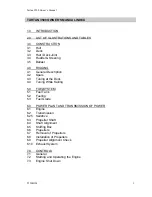
Safety Equipment
9-3
Section 9
DC235 / DC265
Other symptoms that may signal exposure
to CO: dizziness, flushed face, ears ringing,
headaches, tightness of chest or hyperventi-
lation, drowsiness, fatigue or weakness,
inattention or confusion, lack of normal coor-
dination, nausea and unconsciousness. The
victim’s skin also may turn red. A slight
buildup of CO in the human body over sev-
eral hours causes headache, nausea and
other symptoms similar to food poisoning,
motion sickness or the flu. Anyone with
these symptoms should immediately be
moved to an area of fresh air. Have the vic-
tim breath deeply and seek immediate medi-
cal attention. To learn more about CO
poisoning, contact your local health authori-
ties.
Carbon Monoxide Detector
If the carbon monoxide detector is activated,
this indicates the presence of CO, which can
be fatal. Evacuate the cabin immediately.
Make sure all passengers are accounted for.
DO NOT enter the cabin until you know it is
safe and the problem found and corrected.
CO detectors warn occupants of dangerous
accumulation of CO gas. It is automatically
activated whenever the house battery switch
panel feed breaker is "ON." When powered,
the green indicator will flash for ten to fifteen
minutes, indicating the unit is in its warm-up
stage. The green power indicator will stop
flashing when the sensor has reached opti-
mum operating temperature. The indicator
will then switch from flashing green to solid
green, indicating the detector is activate.
Make sure the battery switch is on and the
power light is lit whenever the cabin is occu-
pied.
This device uses a micro controller to contin-
uously measure and accumulate CO levels.
Should a very high level of CO exist, the
alarm will sound within a few minutes. If
small quantities are present or high levels
are short-lived, the detector will accumulate
the information and determine when an
alarm level has been reached.
While a CO detector enhances your protec-
tion from CO poisoning, it does not guaran-
tee it will not occur. Do not use CO detectors
as a replacement for ordinary precautions or
periodic inspections of equipment. Never
rely on alarm systems to save lives; com-
mon sense is still the best form of protection.
Remember, the boat operator carries the
ultimate responsibility to make sure the boat
is properly ventilated and passengers are
not exposed to dangerous levels of CO. Be
alert to the symptoms and early warning
signs of carbon monoxide.
CO detectors are very reliable and rarely
sound false alarms. If the alarm sounds, DO
NOT think it is false. If anyone has been
exposed to CO, move them into fresh air
immediately. Never disable the CO detector
because you think the alarm may be false.
Carbon Monoxide Poisoning
Carbon monoxide (CO) is a by-product of
combustion, is invisible, tasteless, odorless
and is produced by all engines and most
heating and cooking appliances. It exists
wherever fuels are burned to generate
power or heat. The most common sources of
CO on boats are combustion engines, auxil-
iary generators and propane or butane
stoves.
These produce large amounts of CO and
should never be operated while sleeping.
High concentrations of CO can be fatal
within minutes. Many cases of CO poisoning
indicate that while victims are aware they
are not well, they become so disoriented
they are unable to save themselves by either
exiting the area or calling for help. Also,
young children, elderly persons and pets
may be the first affected. Drug or alcohol use
increases the effect of CO exposure. Individ-
uals with cardiac or respiratory conditions
are very susceptible to the dangers of CO.
CO poisoning is especially dangerous during
sleep while victims are unaware of any side
effects.
Low levels of CO over an extended period of
time can be just as lethal as high doses over
a short period. Therefore, low levels of CO
can cause the alarm to sound before per-
sons notice any symptoms.
Summary of Contents for DC / 265
Page 12: ...8 Operator Notes DC265...
Page 16: ...Operator Notes 12 DC235 DC265...
Page 26: ...Operator Notes 2 6 DC235 DC265...
Page 44: ...6 2 Operator Notes DC235 DC265...
Page 50: ...7 6 Operator Notes DC235 DC265...
Page 84: ...12 6 Operator Notes DC235 DC265...
Page 90: ...Operator Notes A 6 DC235 DC265...
Page 92: ...Appendix B Maintenance Log Date Hours Dealer Service Repairs B 2 DC235 DC265 Maintenance Log...
Page 93: ...Maintenance Log B 3 Appendix B DC235 DC265 Date Hours Dealer Service Repairs...
Page 94: ...Appendix B Maintenance Log Date Hours Dealer Service Repairs B 4 DC235 DC265...
Page 95: ...Boating Accident Report C 1 Appendix C DC235 DC265 Boating Accident Report...
Page 96: ...C 2 Appendix C Boating Accident Report DC235 DC265...
Page 97: ...Float Plan D 1 Appendix D DC235 DC265 Float Plan...
Page 98: ...Operator Notes D 2 DC235 DC265...
Page 102: ...Operator Notes E 4 DC235 DC265...
Page 103: ...Schematics F 1 Appendix F DC235 DC265 Schematics DC235...
Page 104: ...F 2 Appendix F Schematics DC235 DC265...
Page 105: ...Schematics F 3 Appendix F DC235 DC265...
Page 106: ...F 4 Appendix F Schematics DC235 DC265...
Page 107: ...Schematics G 1 Appendix G DC235 DC265 Schematics DC265...
Page 108: ...G 2 Appendix G Schematics DC235 DC265...
Page 109: ...Schematics G 3 Appendix G DC235 DC265...
Page 110: ...G 4 Appendix G Schematics DC235 DC265...
Page 111: ...Schematics G 5 Appendix G DC235 DC265...
Page 112: ...G 6 Appendix G Schematics DC235 DC265...
Page 113: ...Schematics G 7 Appendix G DC235 DC265...
Page 114: ...G 8 Appendix G Schematics DC235 DC265...
Page 115: ...Schematics G 9 Appendix G DC235 DC265...
Page 116: ...G 10 Appendix G Schematics DC235 DC265...
Page 117: ...Schematics G 11 Appendix G DC235 DC265...
Page 118: ...G 12 Appendix G Schematics DC235 DC265...
Page 119: ...Schematics G 13 Appendix G DC235 DC265...
Page 120: ...Operator Notes G 14 DC235 DC265...
Page 121: ......
Page 122: ......
















































